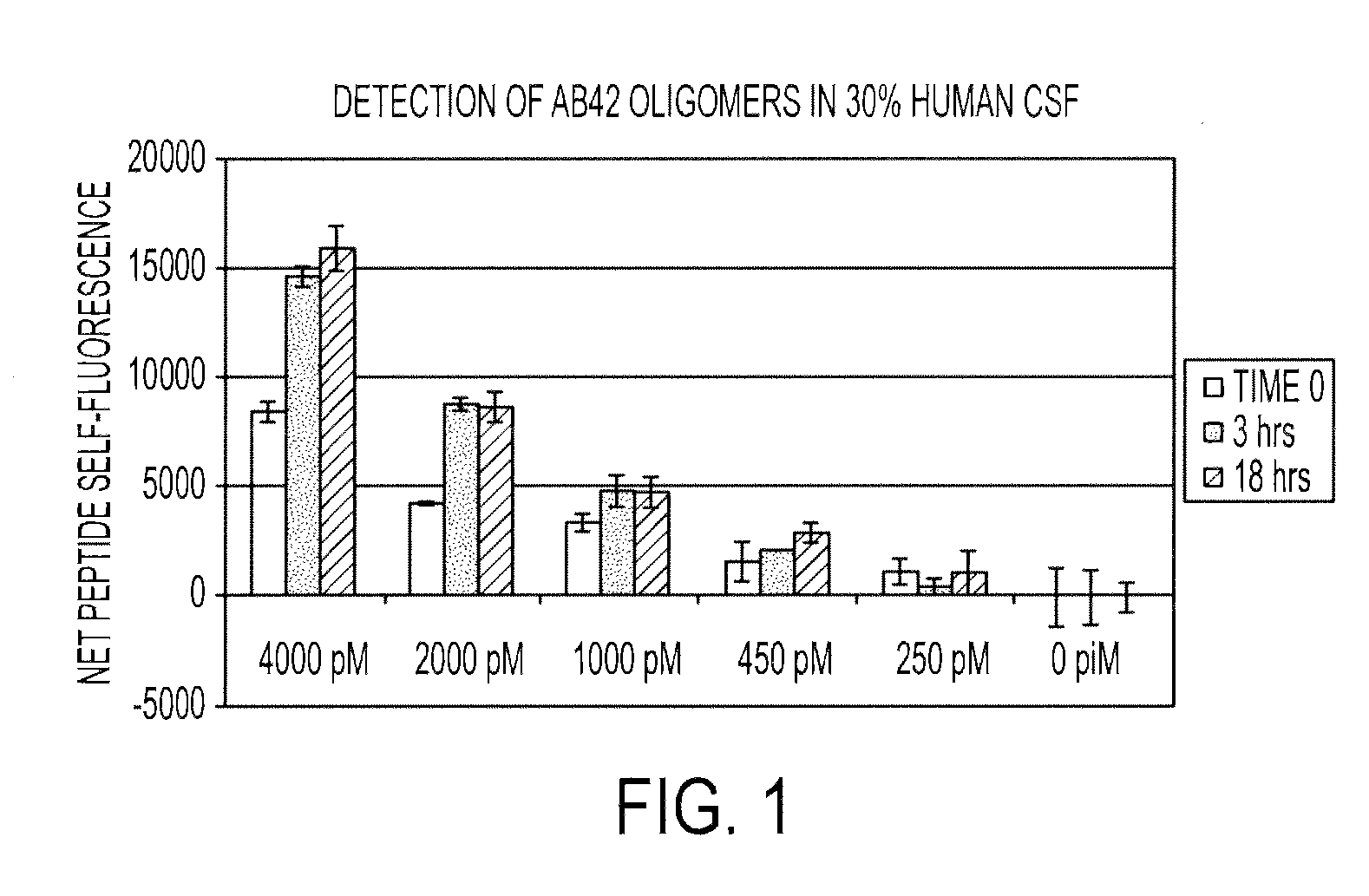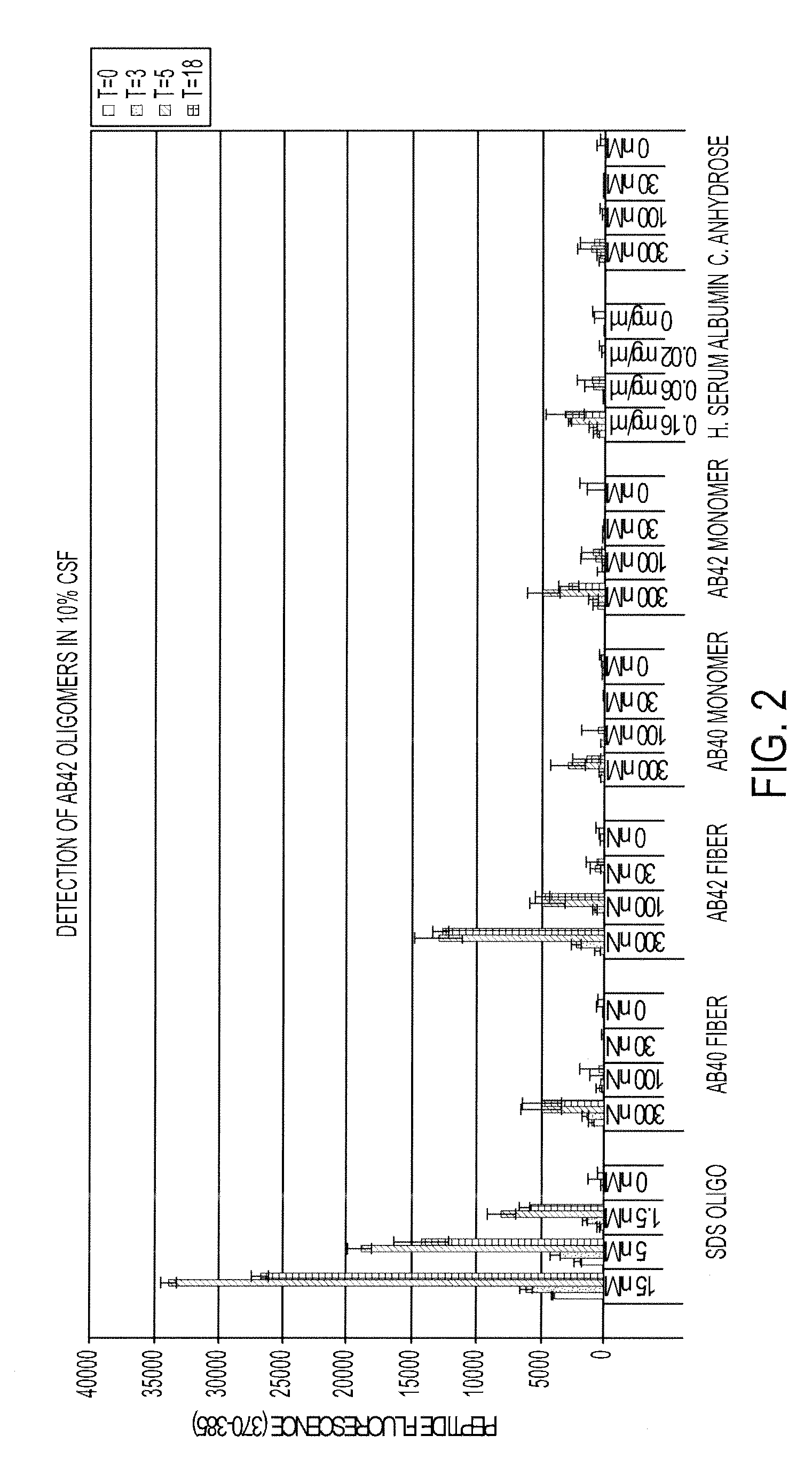Detection and treatment of traumatic brain injury
a traumatic brain injury and protein technology, applied in the field of traumatic brain injury protein detection and treatment, can solve the problem that soldiers are at high risk of brain trauma, and achieve the effect of reducing physical proximity
- Summary
- Abstract
- Description
- Claims
- Application Information
AI Technical Summary
Benefits of technology
Problems solved by technology
Method used
Image
Examples
example 1
Peptide Probes
[0113]Probes for the detection of Aβ aggregates were designed in accordance with the principles described herein. As illustrated in Table 1 and FIG. 8, these peptide sequences are based on amino acids 17-35 of the Aβ peptide, which is a β-sheet forming region of the Aβ peptide. The reference sequence (WT; SEQ ID NO:1) corresponds to the wildtype sequence, with a terminal lysine residue added to facilitate pyrene labeling. These peptides have been shown to bind preferentially to Aβ protein and undergo a conformation shift to generate a signal, as described in U.S. patent application Ser. No. 12 / 695,968. Specific exemplary peptide probes are o described below in Table 2. These probes include modifications that make them more soluble in aqueous solution compared to the reference Aβ peptide sequence. These probes include a dipyrene butyrate (PBA) moiety at the N-terminus and one extending from a lysine side chain near the C-terminus. Additionally, they have been modified t...
example 2
Detection of Synthetic Aβ Aggregates in Media
[0116]70 nM of the peptide probe of SEQ ID NO:2 is incubated with 4000, 2000, 1000, 450, 250 and 0 pM synthetic Aβ42 oligomer (in triplicate) in a solution consisting of 10 mM Hepes (pH 7.0), 0.0074% Tween20 and 30% (v / v) normal human CSF (Bioreclamations, Inc.) for 0, 3, and 18 hours at room temperature in a final volume of 200 μL in a microtiter plate. The plate is then analyzed using a Tecan safire2 fluorescence plate reader. For each sample, the net self-fluorescence response (fluorescence emission from 370-385 nm) is determined by subtraction of the self-fluorescence response of the control (0 pM) from the fluorescence response of the experimental sample. As shown in FIG. 1, as little as 450 pM of Aβ42 oligomer is statistically distinguishable from the control reaction (t-test).
[0117]The specificity of the probe is confirmed as follows. 70 nM of the peptide probe of SEQ ID NO:22 is incubated with several potential substrates in a sol...
example 3
Detection of Synthetic Aβ Aggregates in Brain Extract
[0118]A plate-based ELISA-like assay was developed in which the above-described peptide probes may be used to capture and detect target amyloid beta protein (such as oligomers). FIG. 3 shows a schematic diagram of an exemplary plate-based assay. Streptavidin-coated 96-well plates are prepared, followed by introduction of biotinylated peptide. Sample is then added to the wells and allowed to incubate, such as for two hours at room temperature. Any target amyloid beta protein in the sample will be capture by the immobilized peptide probe. The plate is then washed, such as using a low salt buffer to eliminate potential interfering factors (e.g. endogenous proteins, lipids, and other debris). The remaining amyloid beta aggregate-peptide probe complex is bound to a reporter antibody that is specific for the N-terminus of the amyloid beta sequence (6E10-HRP), and detected by addition of 3,3′,5,5′-tetramethylbenzidine (TMB).
[0119]Such an...
PUM
| Property | Measurement | Unit |
|---|---|---|
| volume | aaaaa | aaaaa |
| pH | aaaaa | aaaaa |
| diameter | aaaaa | aaaaa |
Abstract
Description
Claims
Application Information
 Login to View More
Login to View More - R&D
- Intellectual Property
- Life Sciences
- Materials
- Tech Scout
- Unparalleled Data Quality
- Higher Quality Content
- 60% Fewer Hallucinations
Browse by: Latest US Patents, China's latest patents, Technical Efficacy Thesaurus, Application Domain, Technology Topic, Popular Technical Reports.
© 2025 PatSnap. All rights reserved.Legal|Privacy policy|Modern Slavery Act Transparency Statement|Sitemap|About US| Contact US: help@patsnap.com



